Latex allergy is the body’s abnormal reaction to latex which is otherwise safe. Allergic reaction to latex are manifested by a wide range of symptoms ranging from mild, like sneezing, to severe as in anaphylactic shock.
To understand what latex allergy is, let us first know what latex is.
What is Latex?
Latex is made from the liquid substance from rubber trees native in the tropics. The liquid extract is then processed to make various products which are commonly used at the office and at home, as well as for medical and dental tools and supplies. The following are some of the items made from or with latex.
• Baby-bottle nipples and pacifiers
• Balloons
• Bandages and adhesive tapes
• Condoms
• Dishwashing gloves
• Rubber bands
• Rubber toys
• Sanitary pads and diapers
• Waistbands found on clothing
• Blood pressure cuffs
• Dental dams
• Surgical gloves
• Urinary catheters
• Tourniquets
• root canal fillings
• Resuscitation devices
What is latex allergy?
There are some people who are allergic to latex-containing products due to their allergic reaction to the protein present in the rubber. The softer and more pliable latex products like rubber balloons, condoms and gloves have higher concentration of this allergy-causing protein than the firmer and more solid hard rubber such as in tires. Some latex products such as latex gloves have cornstarch powder to serve as coating. The protein molecules attach themselves to the cornstarch particles. So when the cornstarch particles become airborne, they can be inhaled by people who are allergic to latex, thus causing an allergic reaction.
Symptoms of latex allergy
Some of the symptoms of the latex allergy are:
• Red, watery and itchy eyes
• Short breathing
• Tightness on the chest
• Hives or rashes
• Coughing
• Runny nose or sneezing
• Sores, reddish bumps, cracks on the hands (this happens to those who wear latex gloves)
The aforementioned symptoms usually take place after 12 to 36 hours from exposure to latex. To help resolve the symptoms, use non-latex gloves and glove liners and practice thorough hand care.
Some individuals, on the other hand, have severe allergic reaction to latex, causing anaphylactic allergic attacks, which are highly dangerous and even fatal if not treated promptly. If any of the following is observed, seek immediate medical attention.
• Weak or rapid pulse
• Vomiting
• Nausea
• Wheezing
• Confusion
• Dizziness
• Breathing difficulty
• Fainting/loss of consciousness
Because of the proliferation of latex products anywhere, anyone can develop the allergy. Those with the highest risk of developing the allergy are the workers involved in the rubber industry and the health care workers since they are more exposed to latex than any other work groups. Health care workers who had hay fever have higher chances of acquiring the allergy since recent studies reveal that about 25 percent of them showed indicators of having latex sensitivity.
If you have latex allergy, take the necessary steps to avoid exposure to the allergen. Use products that do not have latex components. Seeking the help of an allergologist will help you understand the allergy better and manage the symptoms more effectively.
